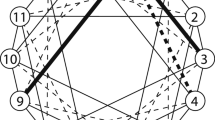Abstract
In modern world, all sciences especially engineering have insatiable demand for more power of processing. Although the use of modern micro-architectures has increased the performance of processors, this increment is only part of speeding up in responding such these demands. In fact, the need of some applications to parallel systems in large scales makes these systems more popular. Therefore, these systems are only the possible way of performing enormous computing power for applications with high performance computing. This paper comprehensively studies the topological properties of a class of n-D networks that are called HyperX from different aspects. In this paper we are going to provide a detailed description of HyperX topology in an algebraic framework with basic features (such as regularity, symmetry, etc.). The important parameters in this topology are evaluated parametrically and compared with other topologies. Having expressed this fact, we emphasize that our study is among the very few attempts reported in the literature to analyze the important parameters that can capture the performance behavior of HyperX topology. Since HyperX has many advantages of high radix switch components, it becomes a serious competitor against the other topologies and high radix networks. Hence, this study leads to finding an optimum topology for these kinds of networks.





Similar content being viewed by others
References
Dally WJ, Towles B (2004) Principles and practices of interconnection networks. Morgan Kaufman, San Francisco
Kim J (2008) High-radix interconnection networks. PhD Thesis, Department of Electrical Engineering, Stanford University, USA
Ahn JH, Binkert N, Davis A, McLaren M, Schreiber RS (2009) HyperX: topology, routing, and packaging of efficient large-scale networks. In: Proceedings of the conference on high performance computing networking, storage and analysis, New York, NY, USA, pp 1–11
Agrawal A (1991) Limits on interconnection network performance. IEEE Trans Parallel Distrib Syst 2(4):398–412
Kim J, Dally WJ, Abts D (2007) Flattened butterfly: a cost-efficient topology for high-radix networks. In: Proceedings of the 34th annual international symposium on computer architecture (ISCA07), San Diego, California, USA, pp 126–137
Leiserson C (1985) Fat-trees: universal networks for hardware efficient supercomputing. IEEE Trans Comput 34(10):892–901
Sullivan H, Bashkow TR (1977) A large scale, homogeneous, fully distributed parallel machine I. In: Proceedings of the 4th annual symposium on computer architecture (ISCA77), vol 5, pp 105–117
Bhuyan LN, Agrawal DP (1984) Generalized hypercube and hyperbus structures for a computer network. IEEE Trans Comput 33(4):323–333
Sarbazi-Azad H (2001) Performance analysis of wormhole routing in multicomputer interconnection networks. PhD Thesis, Department of Science, University of Glasgow, UK
Xu J (2001) Topological structure and analysis of interconnection networks. Kluwer Academic, Dordrecht
Dally WJ (1999) Performance analysis of k-ary n-cube interconnection networks. IEEE Trans Comput 39(6):775–785
Sarbazi-Azad H, Khonsari A, Ould-Khoua M (2010) On the topological properties of grid-based interconnection networks: surface area and volume of radial sphere. Comput J 54(5):726–737
Grimaldi RP (2004) Discrete and combinatorial mathematics: an applied introduction, 5th edn. Addison Wesley, Reading
Pevzner PA (1992) Multiple alignment, communication cost, and graph matching. SIAM J Appl Math 52(6):1763–1779
Author information
Authors and Affiliations
Corresponding author
Rights and permissions
About this article
Cite this article
Azizi, S., Safaei, F. & Hashemi, N. On the topological properties of HyperX. J Supercomput 66, 572–593 (2013). https://doi.org/10.1007/s11227-013-0935-6
Published:
Issue Date:
DOI: https://doi.org/10.1007/s11227-013-0935-6




